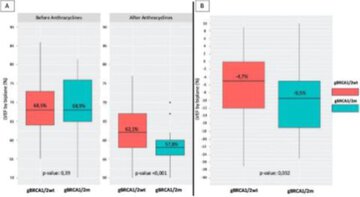Cortés A, Serrano JJ, Cordero D, Menacho M, del Rey JM, Del Campo L, Saavedra C, Chamorro J, Rosero D, Sotoca P, Guillén C, Guerra E, Fernández M, López E, Martínez N, Gion M, Salazar MT, Agudo P, Garrido P, Alonso GL. Anthracyclines-induced cardiotoxicity in patients with early breast cancer carrying germline BRCA1/2 mutation: the BRCAN study
Oncologist. 2024
"Germline BRCA1/2 mutations increase the risk of anthracycline cardiotoxicity in early breast cancer, underscoring the need for personalized cardiological follow-up strategies". - Dr Alfonso Cortés-Salgado -
Summary:
Background: BRCA1/2 genes play a critical role in genome stability and DNA repair. In animal models, loss of cardiomyocyte-specific BRCA1/2 is associated with DNA damage, apoptosis, cardiac dysfunction, and mortality following anthracycline exposure. However, whether these preclinical findings translate to humans remains unclear.
Objective: To assess the impact of germline BRCA1/2 (gBRCA1/2) status on anthracyclines-induced cardiotoxicity (AIC) in patients with early breast cancer and no prior anti-HER2 therapy.
Methods: This single-center retrospective/prospective cohort study focused on early breast cancer patients, treated with anthracycline-based chemotherapy in the neo/adjuvant setting, no prior anti-HER2 therapy, and known gBRCA1/2 status, normal baseline left ventricular ejection fraction (LVEF), and no previous cardiovascular disease. Follow-up assessments included myocardial dysfunction blood biomarkers (MDBB), transthoracic echocardiography (TTE), and quality of life (QoL) questionnaires. The primary objective was LVEF changes comparing BRCA1/2 mutation carriers (gBRCA1/2m) vs non-carriers (gBRCA1/2wt). Secondary objectives included differences in MDBB and QoL.
Results: A total of 137 patients were included (103 gBRCA1/2wt and 34 gBRCA1/2m). Baseline characteristics were similar between groups. Compared to baseline, LVEF% reduction was -4.7[-12.0, 0.0] vs -9.5[-18.0, -5.0] in gBRCA1/2wt vs gBRCA1/2m, (p = .027). After adjusting for confounders, the difference in reduction in LVEF remained statistically significant at -4.5 [95%CI, -8.6, -0.4; p = .032]. No differences between MDBB (C-reactive protein, hsTnI, NT-proBNP, D-Dimer, ST-2, or Galectine-3) or QoL (MLHFQ and EQ5-D index) were detected.
Conclusions: gBRCA1/2m patients could represent a higher-risk population for AIC. gBRCA1/2 status should be one of the factors to consider in deciding on adjuvant anthracycline necessity. This population could benefit from a cardio-oncology closer follow-up and cardioprotective strategies.
Why do you highlight this publication?
This publication provides new clinical evidence that germline BRCA1/2 mutations are associated with an increased risk of anthracycline-induced cardiotoxicity (AIC) in patients with early breast cancer. While preclinical studies had suggested this link, this is one of the first clinical studies to demonstrate a significantly greater decline in left ventricular ejection fraction (LVEF) among BRCA1/2 mutation carriers. Conducted at our institution, this research highlights the importance of integrating genetic information into cardio-oncology risk assessment and supports a more personalized treatment and follow-up strategies in this population.
Publication commented by:
Dr. Alfonso Cortés Salgado
Medical Oncology Service
MOLECULAR PATHOLOGY OF CANCER GROUP-IRYCIS



